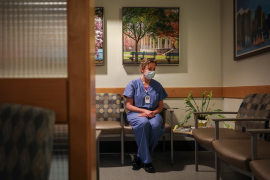Data Brief
Despite a robust economy and low unemployment, more women than ever lack health insurance. In fact, according to The Commonwealth Fund 1998 Survey of Women's Health, one of four women under age 65, or 21 million women, are either uninsured now (18%) or have been at some point in the past year (8%). While Medicare has achieved virtually universal health coverage for women age 65 and older, the survey finds that low- and modest-wage women under age 65 are at especially high risk for being uninsured, as are minority women and women with health problems. Survey responses reveal that women who have had gaps in coverage—as well as women who are currently uninsured—are at double the risk for health care access difficulties compared with women insured throughout the year.
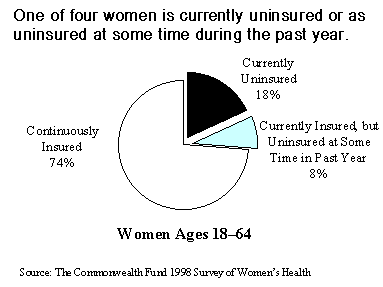
CHARACTERISTICS OF UNINSURED WOMEN UNDER AGE 65
The vast majority of women who had spent a time uninsured—83 percent—are either working or married to a worker and living on low or modest incomes. Seventy percent of women who had spent a time uninsured have family incomes below $35,000.
Employment is no guarantee of health insurance coverage. Indeed, most uninsured women are part of a family with at least one full-time worker. Fifteen percent of uninsured women are in families with at least one-part time worker and no full-time worker. Less than one-fifth of uninsured women are in families in which no one is currently working.
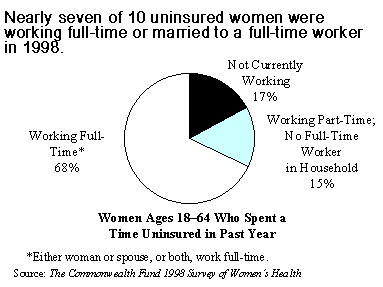
The risk of being uninsured is notably high for low- and modest-income women. Nearly half (49%) of women with family incomes of $16,000 or less, and one of three women with incomes from $16,001 to $35,000, were uninsured some time during the past year. In contrast, only one of six women with incomes from $35,001 to $50,000, and only one of 12 women with incomes above $50,000, were uninsured for a period during the past year. The number of uninsured low- and modest-income women has increased in the past five years. In 1998, 18 percent of women under age 65 were uninsured when surveyed, up from 14 percent in 1993. Uninsured rates jumped among women with incomes of $16,000 or less, rising from 29 to 35 percent.
Reflecting their generally lower incomes, minority women are much more likely to be uninsured than women as a whole. Half of Hispanic women and one-third of African American and Asian American women report having spent a time uninsured in the past year, compared with 21 percent of white women.
LACK OF CONTINUOUS HEALTH INSURANCE IS ASSOCIATED WITH ACCESS PROBLEMS
The survey documents the importance of insurance for access to care. Women who have been uninsured are significantly more likely to face difficulties getting care than women who are able to maintain continuous coverage. Compared with continuously insured women, those who experienced a time uninsured were about three times as likely to have access problems in the past year.
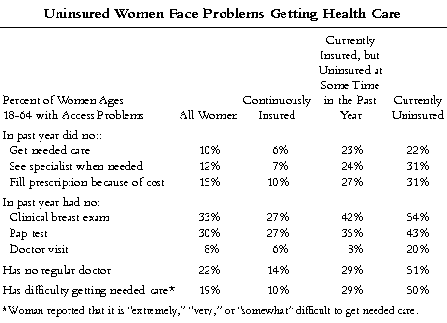
Women who are currently uninsured are at greatest risk for access problems: one-half reported difficulty getting care when needed, and one of five said they had not visited a physician in the past year. Uninsured women are also more likely to forego cost-effective preventive care: two of five have not had a Pap test in the past year and half reported not having a regular doctor. Women who went without health insurance for part of the last year—even if they are now insured—are likely to face health care access difficulties at rates remarkably similar to those for women who are currently uninsured. Gaps in coverage dramatically increase the likelihood of going without care.
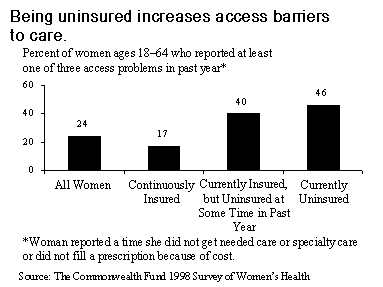
WOMEN WHO HAVE BEEN UNINSURED ARE LESS LIKELY TO REPORT HIGH-QUALITY CARE
Women who have experienced a time without health insurance are less likely to have a regular doctor. As a result, they may have less opportunity to develop an ongoing relationship with a physician or to seek out physicians and health care settings best able to meet their needs. Uninsured women in particular are more likely to rely on emergency departments or busy hospital clinics and to wait for care.
Women who have been uninsured, especially those who are currently uninsured, are less likely than continuously insured women to give excellent ratings to the care provided by their physicians. Fewer than one of three uninsured women surveyed gave an excellent rating for their overall care, for the time the doctor spends with them, or for the extent to which their physicians make sure they understand health problems they have discussed. In contrast, more than two of five continuously insured women gave excellent ratings on these dimensions of care. Only 35 percent of uninsured women, versus 57 percent of continuously insured women, rated their physicians as excellent in treating them with dignity and respect.


